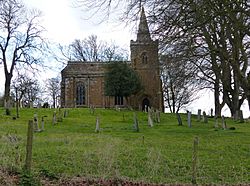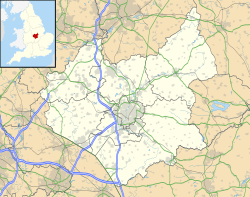Owston Abbey facts for kids

St Andrew's church, Owston, incorporates part of the former abbey.
|
|
| Monastery information | |
|---|---|
| Order | Canons Regular |
| Established | Before 1161 |
| Disestablished | 1536 |
| Dedicated to | St Andrew |
| People | |
| Founder(s) | Robert Grimbald |
| Site | |
| Location | Leicestershire, United Kingdom |
| Coordinates | 52°39′50″N 0°51′23″W / 52.663842°N 0.856526°W |
| Visible remains | Parts incorporated into the current St Andrew's Parish Church. |
Owston Abbey was a special kind of religious building called a monastery in Owston, Leicestershire, England. It was home to a group of monks known as Augustinian Canons.
Contents
The Story of Owston Abbey
How Owston Abbey Began
A man named Robert Grimbald started Owston Abbey before the year 1161. He gave the abbey land, a church, and a manor (a large estate) in Owston to help it get started.
By 1166, the abbey also gained the right to choose the priests for several other churches. These churches were in places like Burrough, King's Norton, Slawston, Tickencote, and North Witham. Around 1341, the abbey also received the manor and church of Muston. They were also given the manor of Normanton by Robert de Golville.
Life at the Abbey
Even with its land and gifts, Owston Abbey was always one of the smaller and poorer Augustinian monasteries. When the Bishop of Lincoln, William Alnwick, visited in 1440, he found the abbey was struggling. It only had an income of about £40 a year, but it owed a lot of money – 100 marks (which was a large debt back then).
The number of canons (monks) living at the abbey changed over time. In 1377, there were 17 canons. By 1440, this number had dropped to 15. By 1534, only 11 canons remained, and by 1536, there were just 6.
The Abbey's End
In 1534, the Abbot (the leader of the abbey) and 11 canons agreed to accept King Henry VIII as the head of the church. This was a big change in England at the time.
In 1535, a survey called the Valor Ecclesiasticus showed that Owston Abbey was among the smaller religious houses. Its yearly income was recorded as £161, 14 shillings, and 2 pence.
The abbey was closed down in 1536, along with many other smaller monasteries. All the canons at Owston Abbey decided to leave their monastic lives. The abbot was given a yearly payment of £18. By 1556, the abbey was described as being "ruined."
What Remains Today
Parts of the old abbey church, including the chancel (the area around the altar), were used to build the current St Andrew's parish church. This church is still on the same site today.
An old gatehouse at the south-west corner of the church was taken down in the 1700s. You can still find traces of old earthworks and foundations (the underground parts of old buildings) to the south and south-west of the church. There are also several old fish-ponds that have been studied by experts. It's believed that the abbey's cloister (an open courtyard) was located to the south of the church, and some stonework from it is still buried underground.
The site of Owston Abbey is now a scheduled monument, which means it's a nationally important historical site. St Andrew's church is also a Grade I listed building, showing its special historical and architectural importance.


